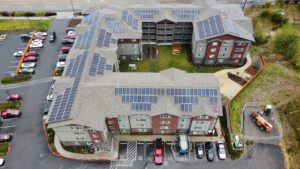Community Solar creates economic, social and environmental justice
Frustrated by the lack of local, state, and federal action to address the climate emergency, in 2019 a group of local activists set out to create tangible change. The team included an environmental organizer, a marine corps veteran, a bartender, a solar installer, and a water protector fresh off the frontlines of oil pipeline resistance. They shared a belief that clean energy must be accessible to everyone.

Where solar energy is concerned, significant barriers exist for people who live in multifamily buildings; for building owners who cannot (or assume they cannot) afford the upfront cost; and for building owners with unsuitable roofs due to shade, orientation or the need for repairs.
The team incorporated as a non-profit organization, Olympia Community Solar, to address these barriers through community solar projects, group purchasing campaigns, and public policy. As president of OCS, Mason Rolph, notes, solar power should be accessible and equitable, “Solar is not only a climate solution, it’s also a vehicle for social and economic justice.”
Since their inception, OCS has completed three major projects. Solarize Thurston organizes individual and group purchase of solar installations. Two community solar projects—the Hummingbird Project at the Hands On Children’s Museum and the Sunflower Project at the Olympia Farmers’ Market—allow people to share in the benefits of a solar array generating electricity elsewhere than on their building.
Solarize Thurston reduces the cost to individuals
Last spring OCS launched a solar group-purchasing program seeking to reduce the costs by turning the normally individual choice of installing solar into a community effort. A solar installer offered a group discount and a credit union provided discounted financing—if fifty households signed up.
The volume-purchasing discount, combined with federal tax credits, made solar panels accessible for many Thurston County families. The program exceeded expectations and contracted 139 solar installations, representing more than $2.7 million dollars of investment.
“Our team was not sure what response we would receive from the community,” Rolph said. “That wasn’t a concern after we passed our campaign goal in less than a month. Participants say that they are shocked by how easy and inexpensive generating your own energy is.”
OCS is expanding the program in 2022 with a goal of 200 participants spanning Thurston, Mason, Lewis, and Pierce counties. The program supported homeowners with sunny roofs, but how can others access solar?
Community solar spreads benefits broadly
The answer is community solar. Community solar allows people to own and benefit from a single solar array. Similar to how a community garden provides farming plots for people who may not have their own garden, a community solar array expands solar access to everyone.
An individual or group buys one or more units of a project. The energy is metered and credited to the participants. In some community solar projects, the energy credits reduce the participants’ electric bills while in other projects the participants periodically get a check for the value their solar units produce.
Local community solar with 97 owners
The Hummingbird Community Solar Project began generating energy in February 2021 after more than eighteen months of organizing. OCS leased the rooftop of the Hands On Children’s Museum, enrolled participants and contracted a solar installer. The technology is impressive—300 solar panels, commercial inverters, and a public online monitoring system.
The truly unique thing about the Hummingbird Project is that it has 97 owners. Participants include 83 individuals and 14 non-profits. Community members could choose to subscribe to a unit (about half of a solar panel) or to donate a unit to a participating non-profit. When the payback period is over, the installation will be donated to the Hands On Children’s Museum.
Community solar will supply all Oly Farmers’ Market energy needs
Over the summer, OCS worked with the Farmers Market and local solar installer South Sound Solar to design an installation that will provide 100% of the markets’ energy needs. This makes it the first net-zero farmers market in Washington. {See “Bringing clean energy to the Farmers’ Market,” WIP, Aug. 2021)
Over the summer more than 100 community members purchased units for themselves or donated units of the project to twelve participating nonprofits. Organizations such as GRuB, the Thurston County Food Bank, Salmon Defense, the Dispute Resolution Center, Homes First and several more participated.
When community members donate solar units they not only help build a solar project, they benefit the community at large by providing long-term support to a nonprofit.
A third community solar project will be available in 2022.
Public support for shifting energy markets away from fossil fuels
In 2021, OCS began working on legislation to fund solar projects for low-income homes and to require utility companies to allow community solar projects to access bill-crediting systems that distribute participants’ energy credits.
The change would allow for a competitive community solar market that provides customers with tangible savings on their electric bills. Rolph estimates that this bill will expand Washington’s addressable solar market five times over and create many new jobs
If the bill is passed, solar providers will be able to apply to the Washington State University Extension Energy Program for project funding. The fund could pay up to 100% of the solar project costs that benefit low-income customers and would reimburse some of the provider’s development expenses. Governor Jay Inslee announced in December that he was proposing a one hundred-million-dollar grant program to install solar panels on buildings throughout the state.
Bringing the sunshine in pays off
In a short period, Olympia Community Solar has helped hundreds of people access the benefits of solar power and created new “green collar” jobs. Last year alone their projects created work for seven different crews from three different solar installers. It has dozens more projects in progress for next year. With the support of Olympia’s residents, the organization’s momentum will continue expanding equitable and accessible solar power for everyone.
Learn more about each program at these dedicated sites:
Solarize Thurston
Hummingbird Project
Sunflower Community Solar

Be First to Comment